Mammalia in the 10th edition of ''Systema Naturae''
In the 10th edition of Systema Naturae (published 1758–1759), Carl Linnaeus described the Mammalia as one of the six classes of animals, characterized by being:[1]
Animals that suckle their young by means of lactiferous teats. In external and internal structure they resemble man: most of them are quadrupeds; and with man, their natural enemy, inhabit the surface of the Earth. The largest, though fewest in number, inhabit the ocean.
Linnaean Characteristics [1]
- Heart: 2 auricles, 2 ventricles. Warm, dark red blood
- Lungs: respires alternately
- Jaw: incombent, covered. Teeth usually within
- Teats: lactiferous
- Organs of Sense: tongue, nostrils, eyes, ears, & papillae of the skin
- Covering: hair, which is scanty in warm climates, hardly any on aquatics
- Supports: 4 feet, except in aquatics; and in most a tail. Walks on the Earth & Speaks
Linnaeus divided the mammals based upon the number, situation, and structure of their teeth.
Primates
- Fore-teeth: cutting, upper 4 parallel, (except in some species of bats which have 2 or none)
- Tusks: solitary, that is, one on each side, in each jaw
- Teats: 2 pectoral
- Feet: 2 are hands
- Nails: (usually) flattened, oval
- Food: fruits, except a few who use animal food
- Homo (humans)
- Homo sapiens – human [2]
- Homo troglodytes – partly based on myth, partly on orangutans [3]
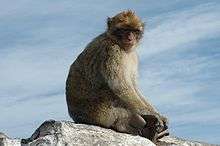
The Barbary macaque was named Simia sylvanus in 1758.
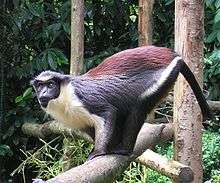
The Diana monkey was given the names Simia diana and Simia faunua.
- Simia satyrus – Bornean orangutan & common chimpanzee
- Simia sylvanus – Barbary macaque
- Simia sphinx – mandrill
- Simia apedia – nomen dubium
- Simia silenus – lion-tailed macaque
- Simia faunus & Simia diana – Diana monkey
- Simia paniscus – red-faced spider monkey
- Simia cephus – moustached guenon
- Simia aygula – nomen oblitum for the crab-eating macaque
- Simia hamadryas – hamadryas baboon
- Simia jacchus – common marmoset
- Simia oedipus – cottontop tamarin
- Simia aethiops – grivet
- Simia midas – red-handed tamarin
- Simia cynamolgus – possibly crab-eating macaque
- Simia apella – tufted capuchin
- Simia morta – nomen dubium
- Simia capucina – white-headed capuchin
- Simia sciurea – common squirrel monkey
- Simia syrichta – Philippine tarsier

The ring-tailed lemur was named Lemur catta
- Lemur tardigradus – red slender loris
- Lemur catta – ring-tailed lemur
- Lemur volans – Philippine flying lemur
- Vespertilio (bats)
- Vespertilio vampyrus – large flying fox
- Vespertilio spectrum – spectral vampire bat
- Vespertilio perspicillatus – Seba's short-tailed bat
- Vespertilio spasma – lesser false vampire bat
- Vespertilio leporinus – greater bulldog bat
- Vespertilio auritus – brown long-eared bat
- Vespertilio murinus – parti-coloured bat
Bruta
- Fore-teeth: none in any jaw
- Tusks: in elephants and manatees
- Feet: with strong hoof-like nails
- Motion: slow
- Food: (mostly) masticated vegetables
- Elephas (elephants)
- Elephas maximus – Asian elephant
- Trichechus (manatees)
- Trichechus manatus – West Indian manatee
- Bradypus (sloths)
- Bradypus tridactylus – pale-throated sloth
- Bradypus didactylus – Linnaeus's two-toed sloth
- Myrmecophaga (anteaters)
- Myrmecophaga didactyla – silky anteater
- Myrmecophaga tridactyla – giant anteater
- Myrmecophaga tetradactyla – southern tamandua
- Manis (pangolins)
- Manis pentadactyla – Chinese pangolin
Ferae
- Fore-teeth: conic, usually 6 in each jaw
- Tusks: longer
- Grinders: with conic projections
- Feet: with claws
- Claws: subulate
- Food: carcasses and preying on other animals
- Phoca (seals)
- Phoca ursina – northern fur seal
- Phoca leonina – southern elephant seal
- Phoca rosmarus – walrus
- Phoca vitulina – harbour seal
- Canis familiaris – domesticated dog [4]
- Canis lupus – grey wolf
- Canis hyaena – striped hyena
- Canis vulpes & Canis alopex – red fox
- Canis lagopus – Arctic fox
- Canis aureus – golden jackal
- Felis (cats)
- Felis leo – lion
- Felis tigris – tiger
- Felis pardus – leopard
- Felis onca – jaguar
- Felis pardalis – ocelot
- Felis catus – domesticated cat [4]
- Felis lynx – Eurasian lynx
.jpg)
The eastern spotted skunk was named Viverra putorius in 1758.
- Viverra ichneumon – Egyptian mongoose
- Viverra memphitis – striped skunk
- Viverra putorius – eastern spotted skunk [5]
- Viverra zibetha – large Indian civet
- Viverra genetta – common genet
- Mustela (weasels & kin)
- Mustela lutris – sea otter
- Mustela lutra – European otter
- Mustela gulo – wolverine
- Mustela barbara – tayra
- Mustela martes – European pine marten
- Mustela putorius – European polecat
- Mustela furo – ferret [4]
- Mustela zibellina – sable
- Mustela erminea – stoat
- Ursus (bears)
- Ursus arctos – brown bear
- Ursus luscus – wolverine
- Ursus meles – European badger
- Ursus lotor – northern raccoon
Bestiae
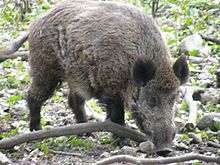
The wild boar was named Sus scrofa in 1758.
- Fore-teeth: indefinite numbers on the sides, always have one extra canine
- Nose: elongate, used to dig
- Food: digs out juicy roots and vermin
- Sus (pigs)
- Sus scrofa – wild boar [4] & domesticated pig
- Sus porcus – red river hog
- Sus tajacu – collared peccary
- Sus babyrusa – Buru babirusa
The Brazilian three-banded armadillo was given the names Dasypus tricinctus & Dasypus quadricinctus.
- Dasypus (armadillos)
- Dasypus unicinctus – southern naked-tailed armadillo
- Dasypus tricinctus & Dasypus quadricinctus – Brazilian three-banded armadillo [6]
- Dasypus sexcinctus – six-banded armadillo
- Dasypus septemcinctus – seven-banded armadillo
- Dasypus novemcinctus – nine-banded armadillo
- Erinaceus (hedgehogs)
- Erinaceus europaeus – European hedgehog
- Talpa (moles)
- Talpa europaea – European mole
- Talpa asiatica – Cape golden mole
- Sorex (shrews)
- Sorex araneus – common shrew
- Sorex cristatus – star-nosed mole
- Sorex aquaticus – eastern mole
- Didelphis (opossums)
- Didelphis marsupialis – common opossum
- Didelphis philander – bare-tailed woolly opossum
- Didelphis opossum – grey four-eyed opossum
- Didelphis murina & Didelphis dorsigera – Linnaeus's mouse opossum [6]
Glires
1_-_Relic38.jpg)
The Indian rhinoceros, Rhinoceros unicornis was placed in the order Glires because the animal's incisors resembled those of rodents. [7]
- Fore-teeth: cutting, 2 in each jaw
- Tusks: none
- Feet: with claws formed for running and bounding
- Food: bark, roots, vegetables, etc., which they gnaw
- Rhinoceros (rhinoceroses)
- Rhinoceros unicornis – Indian rhinoceros
- Rhinoceros bicornis – black rhinoceros
- Hystrix (porcupines)
- Hystrix cristata – crested porcupine
- Hystrix prehensilis – Brazilian porcupine
- Hystrix dorsata – North American porcupine
- Hystrix macroura – Asiatic brush-tailed porcupine
- Hystrix brachyura – Malayan porcupine
- Lepus timidus – mountain hare
- Lepus cuniculus – European rabbit
- Lepus capensis – Cape hare
- Lepus brasiliensis – Brazilian rabbit
- Castor (beavers)
- Castor fiber – European beaver
- Castor moschatus – Russian desman
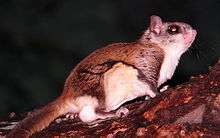
The southern flying squirrel was named Mus volans in 1758.
- Mus (mice & kin)
- Mus porcellus – domestic guinea pig [4]
- Mus leporinus – red-rumped agouti [8]
- Mus lemmus – Norway lemming
- Mus marmota – Alpine marmot
- Mus monax – groundhog
- Mus cricetus – European hamster
- Mus amphibius & Mus terrestris – European water vole
- Mus rattus – black rat
- Mus musculus – house mouse
- Mus avellanarius – hazel dormouse
- Mus sylvaticus – wood mouse
- Mus striatus – typical striped grass mouse
- Mus longipes - midday jird [9]
- Mus jaculus – lesser Egyptian jerboa
- Mus volans – southern flying squirrel [10]
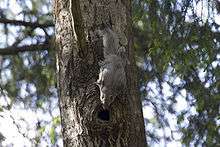
The Siberian flying squirrel was named Sciurus volans in 1758.
- Sciurus (squirrels)
- Sciurus vulgaris – red squirrel
- Sciurus niger – fox squirrel
- Sciurus cinereus – Delmarva fox squirrel
- Sciurus flavus – [nomen dubium] [11]
- Sciurus getulus – Barbary ground squirrel
- Sciurus striatus – eastern chipmunk
- Sciurus volans – Siberian flying squirrel [8]
Pecora
- Fore-teeth: no upper, lower cutting, many
- Feet: hoofed, cloven
- Food: herbs which they pluck, chews the cud
- Stomach: 4:
- the paunch to macerate and ruminate the food
- the bonnet, reticulate, to receive it,
- the omasus, or maniplies of numerous folds to digest it,
- and the abomasus', or caille, fasciate, to give it acescency and prevent putrefaction
- Camelus (camels)
- Camelus dromedarius – dromedary camel
- Camelus bactrianus – domestic Bactrian camel [4]
- Camelus glama – domestic llama [4]
- Camelus pacos – domestic alpaca [4]
- Moschus (musk deer)
- Moschus moschiferus – Siberian musk deer
- Cervus camelopardalis – giraffe
- Cervus alces – elk
- Cervus elaphus – red deer
- Cervus tarandus – reindeer
- Cervus dama – fallow deer
- Cervus bezoarticus – pampas deer
- Cervus capreolus – roe deer
- Cervus guineensis – [nomen dubium] [8]
- Capra hircus, Capra depressa, Capra reversa, & Capra mambrica – domestic goat [4]
- Capra ibex – Alpine ibex
- Capra rupicapra – chamois
- Capra pygmea – royal antelope
- Capra gazella – gemsbok
- Capra cervicapra – blackbuck
- Capra dorcas – dorcas gazelle
- Capra grimmia – common duiker
- Capra ammon – argali
- Ovis (sheep)
- Ovis aries, Ovis guineensis, & Ovis strepsiceros – domestic sheep [4]
- Bos (cattle)
- Bos taurus – domestic cattle [4]
- Bos bonasus – wisent
- Bos bison – American bison
- Bos bubalis – domestic water buffalo [4]
- Bos indicus – zebu [4]
Belluae

The hippopotamus, Hippopotamus amphibius, was named in 1758.
- Fore-teeth: obtuse
- Feet: hoofed
- Motion: heavy
- Food: gathering vegetables
- Equus (horses)
- Equus caballus – domestic horse [4]
- Equus asinus – donkey [4]
- Equus zebra – mountain zebra
- Hippopotamus (hippopotamuses)
- Hippopotamus amphibius – hippopotamus
- Hippopotamus terrestris – South American tapir
Cete
- Fins: pectoral instead of feet
- Tail: horizontal, flattened
- Claws: none
- Hair: none
- Teeth: in some cartilaginous, in some bony
- Nostrils: none, instead of which is a fistulous opening in the anterior and upper part of the head
- Food: mollusca & fish
- Habitation: the ocean
- Monodon (narwhals)
- Monodon monoceros – narwhal
- Balaena (baleen whales)
- Balaena mysticetus – bowhead whale
- Balaena physalus & Balaena boops – fin whale [12]
- Balaena musculus – blue whale
- Physeter (sperm whales)
- Physeter catodon, Physeter macrocephalus, Physeter miscrops & Physeter tursio – sperm whale [13]
- Delphinus phocaena – harbour porpoise
- Delphinus delphis – short-beaked common dolphin
- Delphinus orca – orca
Footnotes
Sources
- Thomas, O. (1911). The Mammals of the Tenth Edition of Linnaeus; an Attempt to fix the Types of the Genera and the exact Bases and Localities of the Species. Proceedings of the Zoological Society of London 1911(1): 120–158
References
- 1 2 Carl von Linné, translated by William Turton (1806). Volume 1. A general system of nature: through the three grand kingdoms of animals, vegetables, and minerals, systematically divided into their several classes, orders, genera, species, and varieties. London: Lackington, Allen, and Co.
- 1 2 3 "Carolius Linnaeus and his names for Primates". Darwiniana. Archived from the original on March 4, 2016. Retrieved August 10, 2010.
- ↑ Bernard Wood & Mark Collard (1999). "The changing face of genus Homo". Evolutionary Anthropology. 8 (6): 195–207. doi:10.1002/(SICI)1520-6505(1999)8:6<195::AID-EVAN1>3.0.CO;2-2.
- 1 2 3 4 5 6 7 8 9 10 11 12 13 14 15 Anthea Gentry; Juliet Clutton-Brock; Colin P. Groves (2004). "The naming of wild animal species and their domestic derivatives". Journal of Archaeological Science. 31: 645–651. doi:10.1016/j.jas.2003.10.006.
- ↑ Jay Butfiloski & Tom Swaygnham. "Eastern Spotted Skunk Spilogale putorius" (PDF). South Carolina Department of Natural Resources. Retrieved August 9, 2010.
- 1 2 Alfred L. Gardner (2008). Marsupials, Xenarthrans, Shrews, and Bats. Volume 1 of Mammals of South America. University of Chicago Press. ISBN 978-0-226-28240-4.
- ↑
- 1 2 3 Don E. Wilson & DeeAnn M. Reeder (2005). Mammal species of the world: a taxonomic and geographic reference, Volume 1 (3rd ed.). Johns Hopkins University Press. ISBN 978-0-8018-8221-0.
- ↑ Cuvier, G. & Griffith, E. (1827). The Animal Kingdom: The class Mammalia 3: 157
- ↑ "Glaucomys volans (Linnaeus, 1758)". Integrated Taxonomic Information System.
- ↑ Samuel N. Rhoades (1894). "Appendix". A reprint of the North American zoology by George Ord. pp. 1–51.
- ↑ W. Perrin (2009). W. F. Perrin, ed. "Balaenoptera physalus (Linnaeus, 1758)". World Cetacea Database. World Register of Marine Species. Retrieved August 9, 2010.
- ↑ W. Perrin (2009). W. F. Perrin, ed. "Physeter macrocephalus Linnaeus, 1758". World Cetacea Database. World Register of Marine Species. Retrieved August 9, 2010.
This article is issued from
Wikipedia.
The text is licensed under Creative Commons - Attribution - Sharealike.
Additional terms may apply for the media files.